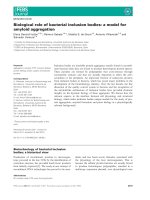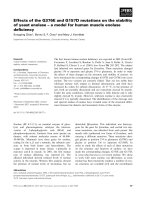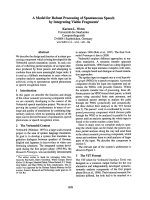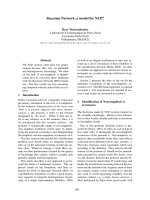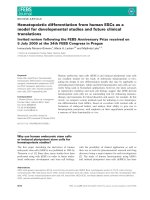INFLUENZA VIRUS a model for learning about disease
Bạn đang xem bản rút gọn của tài liệu. Xem và tải ngay bản đầy đủ của tài liệu tại đây (5.15 MB, 59 trang )
Microbiology: A
Microbiology: A
Systems Approach, 2
Systems Approach, 2
nd
nd
ed.
ed.
Chapter 6: An Introduction to the
Chapter 6: An Introduction to the
Viruses
Viruses
6.1 The Search for the Elusive
6.1 The Search for the Elusive
Virus
Virus
Viruses were too small to be seen with the first
Viruses were too small to be seen with the first
microscopes
microscopes
The cause of viral infections was unknown for
The cause of viral infections was unknown for
years
years
Louis Pasteur first proposed the term
Louis Pasteur first proposed the term
virus
virus
1890s
1890s
Ivanovski and Beijerinck showed that a disease in
Ivanovski and Beijerinck showed that a disease in
tobacco was caused by a virus
tobacco was caused by a virus
Loeffler and Frosch discovered an animal virus that
Loeffler and Frosch discovered an animal virus that
causes foot –and-mouth disease in cattle
causes foot –and-mouth disease in cattle
Many years of experimentation showed what we
Many years of experimentation showed what we
know today and by the 1950s virology had grown
know today and by the 1950s virology had grown
6.2 The Position of Viruses in the
6.2 The Position of Viruses in the
Biological Spectrum
Biological Spectrum
Can infect every type of cell
Can infect every type of cell
Cannot exist independently from the host cell, so
Cannot exist independently from the host cell, so
aren’t considered living things
aren’t considered living things
However, since they can direct life processes they
However, since they can direct life processes they
are often considered more than lifeless molecules
are often considered more than lifeless molecules
Referred to as infectious particles, either active or
Referred to as infectious particles, either active or
inactive
inactive
Obligate intracellular parasites
Obligate intracellular parasites
Cannot multiply unless they invade a specific host
Cannot multiply unless they invade a specific host
cell and instruct its genetic and metabolic
cell and instruct its genetic and metabolic
machinery to make and release new viruses
machinery to make and release new viruses
6.3 The General Structure of
Viruses
Viruses
Figure 6.1
Size Range
Size Range
Smallest infectious agents
Smallest infectious agents
Most are so small, they can only be seen with an
Most are so small, they can only be seen with an
electron microscope
electron microscope
Animal viruses
Animal viruses
Proviruses- around 20 nm in diameter
Proviruses- around 20 nm in diameter
Mimiviruses- up to 450 nm in length
Mimiviruses- up to 450 nm in length
Viewing viruses
Viewing viruses
Special stains and an electron microscope
Special stains and an electron microscope
Negative staining outlines the shape
Negative staining outlines the shape
Positive staining shows internal details
Positive staining shows internal details
Shadowcasting technique
Shadowcasting technique
Figure 6.2
Viral Components: Capsids,
Viral Components: Capsids,
Nucleic Acids, and Envelopes
Nucleic Acids, and Envelopes
Molecular structure- composed of regular,
Molecular structure- composed of regular,
repeating subunits that give rise to their crystalline
repeating subunits that give rise to their crystalline
appearance
appearance
Contain only those parts needed to invade and
Contain only those parts needed to invade and
control a host cell
control a host cell
External coating
External coating
•
Capsid
Capsid
•
Envelope- in 13 of the 20 families of animal viruses
Envelope- in 13 of the 20 families of animal viruses
•
If no envelope, called naked virus
If no envelope, called naked virus
Core
Core
•
DNA
DNA
•
RNA
RNA
The capsid and the nucleic acid together are called
The capsid and the nucleic acid together are called
the
the
nucleocapsid
nucleocapsid
Fully formed virus that is able to establish an
Fully formed virus that is able to establish an
infection in a host cell-
infection in a host cell-
virion
virion
Figure 6.4
The Viral Capsid: The Protective
The Viral Capsid: The Protective
Outer Shell
Outer Shell
Constructed from identical subunits called
Constructed from identical subunits called
capsomers
capsomers
Made up of protein molecules
Made up of protein molecules
Two different types
Two different types
Helical
Helical
•
Rod-shaped
Rod-shaped
capsomers
capsomers
•
Assemble in to helical nucleocapsid
Assemble in to helical nucleocapsid
Figure 6.5
Figure 6.6
Icosahderal
Icosahderal
Three-dimensional, 20-sided figure with 12
Three-dimensional, 20-sided figure with 12
evenly spaced corners
evenly spaced corners
Although they all display this symmetry, there
Although they all display this symmetry, there
are wide variations
are wide variations
Figure 6.7
Figure 6.8
Figure 6.9
Figure 6.10
The Viral Envelope
The Viral Envelope
Enveloped viruses
Enveloped viruses
take a bit of the host
take a bit of the host
cell membrane in the form of an envelope
cell membrane in the form of an envelope
In the envelope, some or all of the regular
In the envelope, some or all of the regular
membrane proteins are replaced with viral
membrane proteins are replaced with viral
proteins
proteins
Some proteins form a binding layer
Some proteins form a binding layer
between the envelope and the capsid
between the envelope and the capsid
Glycoproteins remain exposed as
Glycoproteins remain exposed as
spikes
spikes
(peplomers)- essential for attachment
(peplomers)- essential for attachment
Functions of the Viral
Functions of the Viral
Capsid/Envelope
Capsid/Envelope
Protects nucleic acids
Protects nucleic acids
Help introduce the viral DNA or RNA into a
Help introduce the viral DNA or RNA into a
suitable host cell
suitable host cell
Stimulate the immune system to produce
Stimulate the immune system to produce
antibodies that can protect the host cells
antibodies that can protect the host cells
against future infections
against future infections
Nucleic Acids: At the Core of a
Nucleic Acids: At the Core of a
Virus
Virus
Genome
Genome
- the sum total of the genetic
- the sum total of the genetic
information carried by an organism
information carried by an organism
Number of viral genes compared with a call-
Number of viral genes compared with a call-
quite small
quite small
They only have the genes necessary to
They only have the genes necessary to
invade host cells and redirect their activity
invade host cells and redirect their activity
Some viruses are exceptions to the rules re:
Some viruses are exceptions to the rules re:
DNA and RNA
DNA and RNA
Parvoviruses contain single-stranded DNA
Parvoviruses contain single-stranded DNA
Reoviruses contain double-stranded RNA
Reoviruses contain double-stranded RNA
DNA Viruses
DNA Viruses
ssDNA
ssDNA
dsDNA
dsDNA
linear
linear
circular
circular
RNA Viruses
RNA Viruses
Mostly single-stranded
Mostly single-stranded
Positive-sense RNA: genomes that are ready
Positive-sense RNA: genomes that are ready
for immediate translation into proteins
for immediate translation into proteins
Negative-sense RNA: genomes have to be
Negative-sense RNA: genomes have to be
converted into the proper form to be made
converted into the proper form to be made
into proteins
into proteins
Segmented- individual genes exist on
Segmented- individual genes exist on
separate pieces of RNA
separate pieces of RNA
Other Substances in the Virus
Particle
Particle
Other Substances in the Virus Particle
Other Substances in the Virus Particle
Can contain enzymes for specific operations
Can contain enzymes for specific operations
within the host cell
within the host cell
Polymerases to synthesize DNA and RNA
Polymerases to synthesize DNA and RNA
Replicases to copy RNA
Replicases to copy RNA

